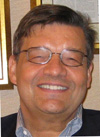| Home | Blog | Ask This | Showcase | Commentary | Comments | About Us | Contributors | Contact Us |

Localizing a Washington scoop the (almost) easy waySHOWCASE | November 324, 2009Going online for Congressional Research Service reports and hearings transcripts provides a big assist to reporters anywhere in their coverage of Washington, DC, news. Writer Andrew Kreig describes how.
By Andrew Kreig Wouldn’t it be nice if harried reporters could break Improved databases provided by the Congressional Research Service (CRS) and congressional testimony can help, as I saw this month in developing a health care story for the Huffington Post and elsewhere. To be sure, my story was modest in scope and even more limited in impact amid the torrent of all the other health reform coverage this fall. Even so, an account of its genesis might prove helpful as we all strive to be more efficient in reaching more markets in less time: On Oct. 15, a tipster suggested that I drop into an informal weekly strategy meeting of health reform advocates in the On this occasion, the Rev. Walter Fauntroy, a former Washington, DC, delegate to Congress (the District’s first such delegate), argued that a then-forthcoming hearing on Oct. 27 should illustrate why basic health care should be a civil right. Fauntroy has rare experience in shepherding such aspirations into law. As an aide to Dr. Martin Luther King, Jr., Fauntroy helped organize the 1963 March on Washington and took part in the three 1965 civil rights marches in Selma, Alabama. These iconic marches led directly to the passage of the 1964 Civil Rights Act and the 1965 Voting Rights Act. Even with this historic dimension, I didn’t immediately see the story possibilities, at least for me as a freelancer primarily focused on other fields. That changed two days later when I attended a National Press Club forum featuring 16 journalists who volunteered part of their Saturday to share their suggestions on covering Capitol Hill. Congressional Quarterly reporter Tim Starks put down a marker against Later that afternoon, I reflected on Fauntroy’s hopes and track-record, and decided to locate him for an interview that night. He then portrayed a unique congressional town-hall style hearing and rally that would showcase the plight of the sick people facing death because their insurance had expired. That preview inspired Regardless of the wisdom or likelihood of any health reform proposals now pending before Congress, my focus here is the tools increasingly available to help make reporting on such complex topics reasonably viable on short notice. As a start, journalists can read the reports that the bipartisan Congressional Research Service generates to help elected officials. Those reports - let’s call them “Cliff’s Notes for Congress” - typically are not directly available to the public, except as a favor from a congressional office. But the reports can now be obtained online by anyone thanks to an independent searchable website called Open CRS, created by non-profits. That said, the CRS reports tend to be too bland for much direct quotation. The solution? Also use material from congressional hearings, which provide an array of quotable experts and those directly aggrieved. True, the hearing chairs tend to stack the witnesses to favor the majority’s preferred views and the chair’s home state. But overlapping Senate and House committees expand the range of testimony. And Internet searches enable us to identify other experts from state hearings, court cases and similar venues. Why would reporters who seek exclusives want to use publicly available testimony? For one thing, the testimony is best used to flesh out a story, not to generate the scoop itself. Also, most congressional testimony is rarely covered in depth, and thus can provide fresh material. Here’s why: Many witnesses are announced in perfunctory manner only a few days before the hearing itself. Also, most of the regular reporters covering hearings are too busy to focus upon more than a few witnesses. Other witnesses of stature might find their testimony ignored, and thus be eager to work closely with a reporter who’s interested enough to follow up, even by phone. To sum up, tipsters and the right attitude by a reporter are, of course, the key to nailing a story, as ever. But modern research tools facilitate the next steps so much that reporters based anywhere can increasingly crack a DC-based story and explore its ramifications around the country. In that spirit of efficiency, let’s multitask by drawing from Fauntroy’s final words at his hearing, captured here on video as he sought to convey what inspired his generation of five decades ago: “You can do it!” he said. “We can do it - if we put our hearts and our minds to it. Let’s go do it!”
|



